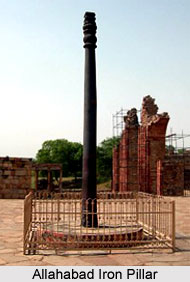 The Allahabad Pillar inscription or Allahabad Prasasti is one of the most important epigraphic evidences of the Imperial Guptas. Composed by Harishena, Allahabad Pillar inscription delineates the reign of the Guptas in ancient India. Achievements of different rulers of the Gupta lineage are also mentioned in the Allahabad Pillar Inscription. Harishena, who composed the Allahabad Prasasti, was the court poet and minister of Samudragupta. Parts of Allahabad Prasasti were composed in verse and other parts, in prose. The verse portion contained eight stanzas, which is followed by the prose portion. The Allahabad Prasasti composed during Samudragupta`s reign, delineates a vivid description of the reign and conquest of Samudragupta. Allahabad Prasasti, composed by Harishena, does not bear any date and for this reason, historians have presumed that it was composed probably before the Ashwamedha Yajna performed by Samudragupta. They have opined this on the basis that there is no mention of the Ashwamedha Yajna completed by Samudragupta. The Allahabad Prasasti was originally engraved on the Ashokan Pillar in Kausambhi near Allahabad. Later it was removed to the Allahabad fort.
The Allahabad Pillar inscription or Allahabad Prasasti is one of the most important epigraphic evidences of the Imperial Guptas. Composed by Harishena, Allahabad Pillar inscription delineates the reign of the Guptas in ancient India. Achievements of different rulers of the Gupta lineage are also mentioned in the Allahabad Pillar Inscription. Harishena, who composed the Allahabad Prasasti, was the court poet and minister of Samudragupta. Parts of Allahabad Prasasti were composed in verse and other parts, in prose. The verse portion contained eight stanzas, which is followed by the prose portion. The Allahabad Prasasti composed during Samudragupta`s reign, delineates a vivid description of the reign and conquest of Samudragupta. Allahabad Prasasti, composed by Harishena, does not bear any date and for this reason, historians have presumed that it was composed probably before the Ashwamedha Yajna performed by Samudragupta. They have opined this on the basis that there is no mention of the Ashwamedha Yajna completed by Samudragupta. The Allahabad Prasasti was originally engraved on the Ashokan Pillar in Kausambhi near Allahabad. Later it was removed to the Allahabad fort.
Since the first two stanzas of the verse portion are damaged, these are considered illegible. The third stanza refers to the character of Samudragupta, his versatility and good qualities. The fourth stanza mentions the nomination of Samudragupta by his father Chandragupta I and his consecration to the throne. Though the sixth and seventh stanzas of the inscription are partly damaged, yet, from the available part it has been presumed by scholars that those stanzas referred to certain wars, probably with his kinsmen and Samudragupta`s victory over them. The seventh and eighth stanzas and the prose text, narrates the conquests of Samudragupta.
Since several lines of the Allahabad Prasasti were damaged, it is not possible to describe what was mentioned in those lines. Yet historians after a prolonged study of the available part provide several details about the reign of Samudragupta. Lines 13 to 15 of the inscription refer to his conquest of the three kings of the north. They were Achyuta, Nagasena and Ganapati Naga, all belonging to the Naga dynasty.
Lines 19-20 describe Samudragupta`s Deccan campaign. The names of 12 Deccan kings are mentioned in the Allahabad Prasasti, viz. -Mahendra of Kosala, Vyaghraraja of Mahakantara, Mantaraja of Kaurala, Mahendragiri of Pistapuram, Svamidatta of Kottura, Damana of Erandapalla, Vishnugopa of Kanchi, Nilaraaja of Avamukta, Hastivarmana of Vengi, Ugrasena of Palakka, Kuvera of Devarashtra, and Dhananjaya of Kushtalapuara.
Lines 21 to 23 mention the names of the nine kings of Aryavarta defeated by Samudragupta. Among these nine kings three Aryavarta kings mentioned earlier in lines 13 to 14 are also included. Apart from those three Naga kings, the rest who were defeated by Samudragupta were- Rudradeva, Matila, Nagadatta, Chandravarmana, Nandin and Balavarmana. Apart from that, Samudragupta`s conquest of the Atavika kings is also mentioned in Allahabad Prasasti.
Line 22 specially describes about the five frontier kingdoms, which were occupied by the Gupta king Samudragupta. Moreover it has been inscribed in Allahabad Prasasti that those frontier kingdoms were bound to pay homage or tribute to Samudragupta. Line 22 also mentions the names of nine tribes viz: -Malavas, Arjunayas, Yaudheyas, Madrakas, Abhiras the Prarjunas, Sanakanikas, Kakas, Kharaparikas etc, who had offered allegiance and tribute to Samudragupta.
Line 24 mentions the names of the foreign kings, who paid homage and offered allegiance to Samudragupta. Not only that, they also had offered the hands of their daughters in order to show him respect. Among the alien powers, mention may be made of Daivaputra-Shahi- Shahanusahi, Saka Murandas, the Simhalese, and the Sarvadvipavasin.
Historians, both ancient and modern, have considered the historical value of Allahabad Prasasti. The famous Allahabad Prasasti or the Allahabad Pillar inscription provides a pretty impressive list of kings and tribal republics that were conquered by Samudragupta. As a whole, the list of conquests by Samudragupta is vividly described in Allahabad Prasasti. However the fact remains that the famous epigraphic evidence, Allahabad Prasasti was a eulogy composed by Harishena, minister of Samudragupta. According to some scholars since Allahabad Prasasti was composed by the court poet of Samudragupta under his patronage, therefore, it might contain some exaggeration in it. Allahabad Prasasti is inscribed with ornamental and literary Sanskrit, befitting the taste of the elite class of the time. Kausambhi has pointed out that while the Ashokan edicts were written in colloquial language, Prakrit was full of modesty and humble in tone. The Allahabad pillar inscription described the eulogy and Prasasti of a king, couched in the court language of the elite class and full of imperial attitude, reflecting the glory of the imperial Guptas.






































